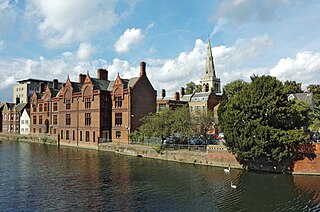History
Cox was born in London, "within the sound of Bow Bells", a son of a hat-maker with an established business in the city. He was educated at St Saviour's School, a classmate of Sydney Waterlow. Cox served an apprenticeship, but left the trade to train as a schoolteacher at the Normal College, Borough Road, run by the British and Foreign Bible Society. The principal, Henry Dunn (1800–1878), author of Principles of Teaching, or The Normal School Handbook 1837, offered him a position with the projected branch of the school in Cairo, but the scheme changed with the Egyptian boys being brought to London instead, and Cox was put in charge of a school in Gloucester. [1]

Sir Sydney Hedley Waterlow, 1st Baronet was an English philanthropist and Liberal Party politician, principally remembered for donating Waterlow Park to the public as "a garden for the gardenless".

Borough Road is in Southwark, London SE1. It runs east-west between St George's Circus and Borough High Street.

The British and Foreign Bible Society, often known in England and Wales as simply the Bible Society, is a non-denominational Christian Bible society with charity status whose purpose is to make the Bible available throughout the world.
While there, he served as lay preacher at the village of Longney. His next post was to a school in Croydon, then was trained as a missionary at the Congregational Home Mission College, near Bedford. He was then sent to serve as pastor at the Congregational Church at Market Weighton in the East Riding of Yorkshire, and after four years received the call to Adelaide, [1] which he accepted, perhaps influenced by his sister Martha Cox (1826 – 25 June 1919), who married Charles Cleeve Collison (1820 – 7 November 1884) and was mother of Charles Nicholas Collison and emigrated to South Australia in 1849 or 1850.

Longney is a village on the river Severn 5 miles south-west of Gloucester, Gloucestershire, England within the parish of Longney and Epney. The parish is long and narrow and the main trades are agricultural with several farms throughout it. Longney is the Saxon name meaning a long island. The population of the Longney and Epney parish is 285 (2011).

Croydon is a large town in south London, England, 9.5 miles (15.3 km) south of Charing Cross. The principal settlement in the London Borough of Croydon, it is one of the largest commercial districts outside Central London, with an extensive shopping district and night-time economy.

Bedford is the county town of Bedfordshire, England. The town has an estimated (2017) population of 87,590, whereas the Borough of Bedford had an estimated population of 169,912.
- The Congregational (or "Independent") Church in Adelaide, founded by T. Q. Stow, from November 1840 had a chapel in Freeman Street (later part of Gawler Place). In 1851 a breakaway group led by William Peacock and I. J. Barclay founded their "Ebenezer Chapel" opened in June 1851 on land donated by Peacock near the old East Terrace Market. [2]
Cox arrived in South Australia with his widowed mother Sarah Cox (c. 1891 – 3 December 1865) aboard Victoria in November 1857 and preached his first sermon at the Ebenezer Place (named for the chapel and not vice versa) [3] chapel. Soon the little church ("obscurely situated in a dirty lane off Rundle street" — Rev. W. Harcus) was full to overflowing, and a larger premises was clearly called for.
- A public meeting was held at White's Assembly Rooms, with William Peacock presiding over a gathering of 1,000 people. Vigorous addresses were delivered by the Hons. J. H. Barrow, Alexander Hay and Thomas Reynolds and Revs. William Butters, William Harcus, and Silas Mead [4] of the Flinders Street Baptist Church, and as a result plans for a new building were soon under way.
- The cornerstone of the new Hindmarsh Square Church was laid by William Peacock on 21 August 1861 and new building, built to seat 450 and with its schoolroom and vestries completed a year later.
Rev. Cox preached his first sermon in the new church on Sunday 7 September, assisted by Charles Manthorpe, and C. W. Evan, and was uninterruptedly associated with this church until 1897. He had a most harmonious relationship with his "flock", and resisted invitations, possibly more lucrative, to leave for Melbourne. He has been described as a tireless worker for the sick, the aged and the dispossessed, notably the Aboriginal population. He was closely connected with the London Missionary Society, the South Australian Auxiliary of the British and Foreign Bible Society and Union College. Cox was twice Chairman of the Congregational Union, and occupied the post of secretary for 17 years. He was secretary of the Fraternal Association of Congregational Ministers and chairman of the Aborigines' Friends' Association. He was, with George Taplin, largely instrumental in establishing the Point Mcleay Mission. Cox was an authority on art and frequently called upon to act as judge at art exhibitions conducted by schools and amateur art groups, but reluctantly had to relinquish this pleasant duty when faced with failing eyesight.
Rev. Charles Manthorpe was a Congregationalist minister remembered for his 36-year pastorate in Glenelg, South Australia.

Cadwallader William Evan, generally referred to as Rev. C. W. Evan, was a Congregationalist minister in colonial South Australia, the first to serve at the Stow Memorial Church, Flinders Street, Adelaide.

The London Missionary Society was a predominantly Congregationalist missionary society formed in England in 1795 at the instigation of Welsh Congregationalist minister Dr Edward Williams working with evangelical Anglicans and various nonconformists. It was largely Reformed in outlook, with Congregational missions in Oceania, Africa, and the Americas, although there were also Presbyterians, Methodists, Baptists and various other Protestants involved. It now forms part of the Council for World Mission (CWM).
He resigned his pastorate on 21 November 1897 and died eight years later, and was succeeded by Rev. S. Lenton, who served the Hindmarsh Square Church from 1898 to 1904.
His widow presented his valuable coin collection to the University, [5]


